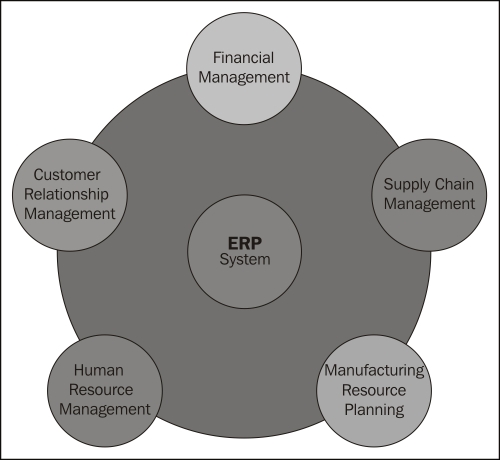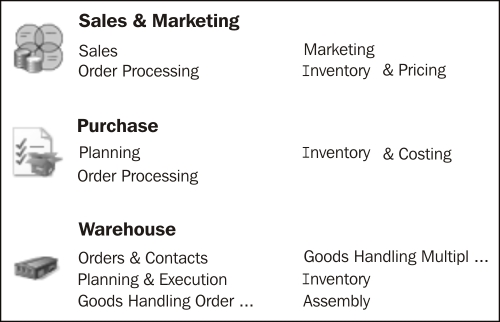NAV 2013 is an integrated set of business applications designed to service a wide variety business operations. Microsoft Dynamics NAV 2013 is an ERP system where ERP stands for Enterprise Resource Planning. An ERP system integrates internal and external data across a variety of functional areas including manufacturing, accounting, supply chain management, customer relationships, service operations, management of human and other resources, and others. By having many related applications well integrated, a full-featured ERP system provides an enter once, use many ways information processing toolset.
NAV 2013 ERP includes the following (and more):
Basic accounting functions (for example, general ledger, accounts payable, accounts receivable)
Order processing and inventory (for example, sales orders, purchase orders, shipping, inventory, receiving)
Relationship management (for example, vendors, customers, prospects, employees, contractors, and so on)
Planning (for example, MRP, sales forecasting, production forecasting)
Other critical business areas (for example, manufacturing, warehouse management, fixed assets)
The following diagram illustrates conceptually how the various functions integrate into a whole to form an ERP system:

A good ERP system, such as NAV 2013, is modular in design, which simplifies implementation, upgrading, modification, integration with third-party products and expansion for different types of clients, for Internet access, and so on. All the modules in the system share a common database and, where appropriate, common data.
The grouping of individual NAV 2013 functions that follows is based on the Departments Menu structure, supplemented by information from Microsoft marketing materials. Some of the groupings are a bit arbitrary; the important thing is to obtain a reasonable grasp of the overall components that make up the NAV 2013 ERP system.
NAV 2013 has two quite different styles of user interfaces. One UI, the Development Environment, is essentially similar to the previously used Classic Client and targets developers. The other UI style, the Role Tailored Client, targets end users. The example images in the following module descriptions are from the Role Tailored Client Departments menu.
Financial Management is the foundation of any ERP system. No matter what the business is, the money must keep flowing, and the flow of money must be tracked. The tools which help to manage the capital resources of the business are part of NAV's Financial Management module. These include all or part of the following application functions:
General Ledger: Manages the overall finances of the firm
Cash Management and Banking: Manages the inventory of money
Accounts Receivables: Tracks the incoming revenue
Accounts Payables: Tracks the outgoing funds
Analytical Accounting: Analyzes the various flows of funds
Inventory and Fixed Assets: Manages the inventories of goods and equipment
Multi-Currency and Multi-Language: Supports international business activities
The Financial Management section of the Departments menu is as follows:

NAV Manufacturing is general purpose enough to be appropriate for Make to Stock (MTS), Make to Order (MTO), Assemble to Order (ATO) as well as various subsets and combinations of those. Although off-the-shelf NAV is not particularly suitable for most process manufacturing and some of the very high volume assembly line operations, there are third-party add-on and add-in enhancements available for these applications. As with most of the NAV application functions, Manufacturing can be implemented to be used in a basic mode or as a full-featured system. NAV Manufacturing includes the following functions:
Product Design (BOMs and Routings): Manages the structure of product components and the flow of manufacturing processes
Capacity and supply requirements planning: Tracks the intangible and tangible manufacturing resources
Production scheduling (infinite and finite), Execution, and tracking: Tracks the planned use manufacturing resources, both on an unconstrained and constrained basis
The Manufacturing section of the Departments menu is as follows:

Obviously, some of the functions categorized as part of NAV Supply Chain Management (for example, sales, purchasing, and so on) are actively used in almost every NAV implementation. As a whole, these constitute the base components of a system appropriate for a distribution operation. The Supply Chain applications in NAV include all or parts of the following applications:
Sales order processing and pricing: Supports the heart of every business, including entering, pricing, and processing sales orders
Purchasing (including Requisitions): Includes planning, entering, pricing, and processing purchase orders
Inventory Management: Manages inventories of goods and materials
Warehouse Management including receiving and shipping: Manages the receipt, storage, retrieval, and shipment of material and goods in warehouses
Even though we might consider Assembly part of Manufacturing, the standard NAV 2013 Departments menu includes it in the Warehouse section.
The Supply Chain Management section of the Departments menu is as follows:

Although Microsoft marketing materials identify Business Intelligence and reporting as though it were a separate module within NAV, it's difficult to physically identify it as such. Most of the components that are used for BI and reporting purposes are (appropriately) scattered throughout various application areas. In the words of one Microsoft document, Business Intelligence is a strategy, not a product. Functions within NAV that support a Business Intelligence strategy include the following:
Standard Reports: These are distributed ready-to-use by end users
Account schedules and analysis reports: These use a very specialized report writer targeted only at General Ledger data
Query, XMLport and Report Designers: These are developer tools to support the creation of a wide variety of report formats, charts, XML and CSV files
Analysis by dimensions: This is a capability embedded in many of the other tools
Interfaces into Microsoft Office including Excel: These support the communications of data either into NAV or out of NAV
RDLC report viewer: This provides the ability to present NAV data in a variety of textual and graphic formats, includes user interactive capabilities
Interface capabilities such as Automation Controllers and web services: These are technologies to support interfaces between NAV 2013 and external software products
NAV's Relationship Management functionality is definitely the "little sister" (or, if preferred, "little brother") to the fully featured stand alone Microsoft CRM system. The big advantage of RM is that it's tight integration with the NAV customer and sales data. For those who need the full Microsoft CRM, a module connecting it to NAV 2013 is available.
Also falling under the heading of Customer Relationship module is the NAV Service Management (SM) functionality. While the RM component shows up in the menu as a part of sales and marketing, the SM component is identified as an independent function in the menu structure.
NAV Human Resources (HR) is a very small module, but relates to a critical component of the business, the people. Basic employee data can be stored and reported via the master table (in fact, one can use HR to manage data about individual contractors in addition to employees). A wide variety of individual employee attributes can be tracked by use of the following dimensions fields:
Employee tracking: Maintains basic employee description data
Skills inventory: Maintains an inventory of the capabilities of employees
Absence tracking: Maintains basic attendance information
Employee statistics: Tracks government required employee attribute data such as age, gender, length of service, and so on
The NAV Project Management module consists of the jobs functionality supported by the resources functionality. Projects can be short or long term. They can be external (in other words billable) or internal. This module is often used by third parties as the base for vertical market add-ons (for example, for construction or job-oriented manufacturing). This application area includes parts or all of the following functions:
Budgeting and cost tracking: Manages project finances
Scheduling: Plans project activities
Resource requirements and usage tracking: Manages people and equipment
Project accounting: Tracks the results



